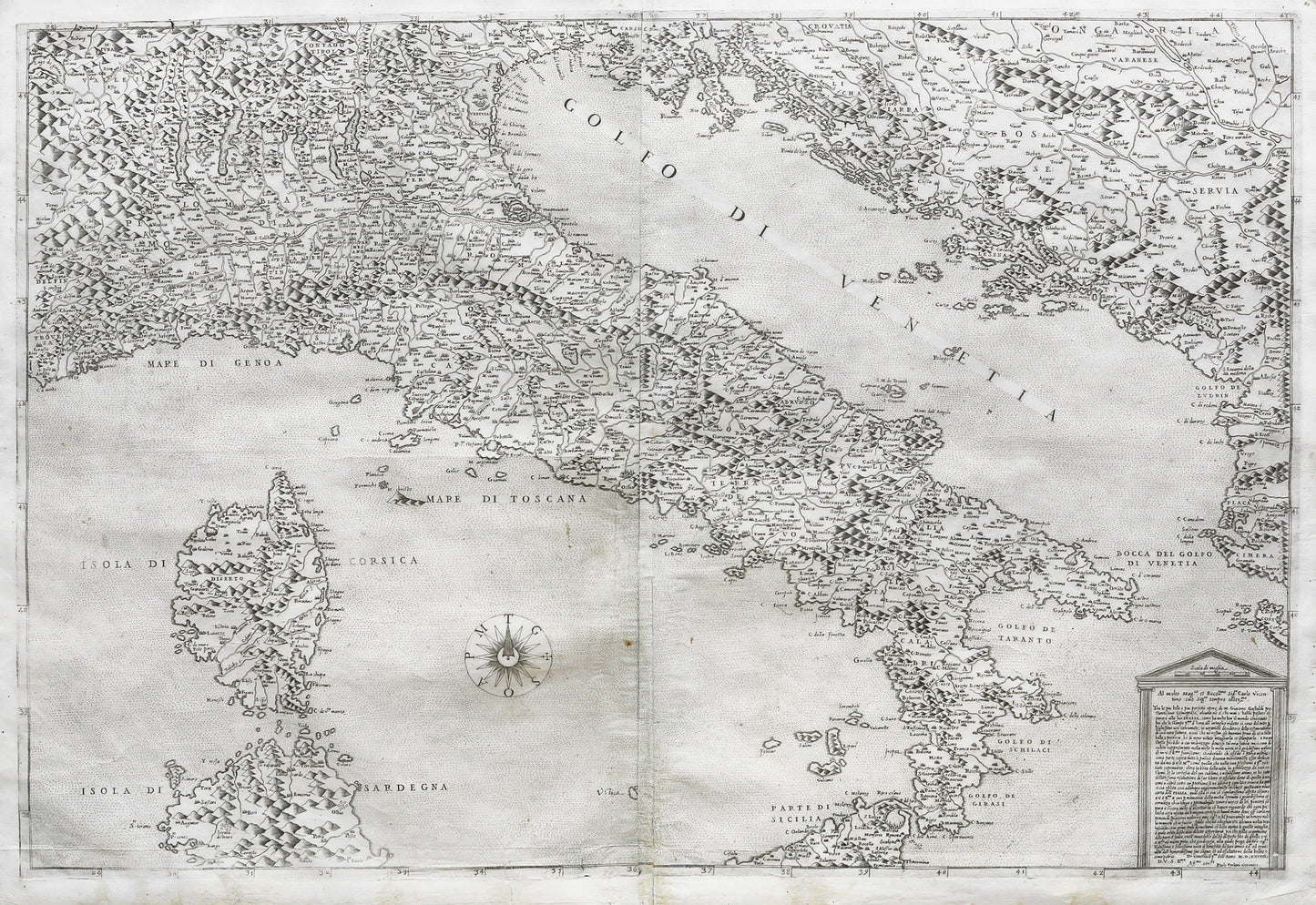from: 1016 Map Inventory
Forlani, Paolo (1560-1571) & Gastaldi, Giacomo (1500-1566). Italy. Venice: 1569
Forlani, Paolo (1560-1571) & Gastaldi, Giacomo (1500-1566). Italy. Venice: 1569
Couldn't load pickup availability
Paolo Forlani (1560-1571) & Giacomo Gastaldi (1500-1566)
[Italy] [Ded. to Carlo Vicentino] Al Molto magno. et exccellmo Sigor. Carlo Vicentino sup sigor sempre ossexmo. Tra Ie piu belle e plu perfette opera di M. Giacomo Gastaldi prestantissimo Cosmografo, alcuna no e’ che mai s’habbi possuto coparare alla sua Italia .. . Di Venetia il pm« dell Anno MDLXVIIII Paolo Forlani Veronese.
Engraved map
Venice: 1569
22" x 31 3/16" sheet; 33 1/2" x 42 3/4" framed
A highly important and influential map, the apex of Gastaldi’s cartographer’s vision of Italy, and certainly one of his great masterpieces. This is Forlani’s derivative of Gastaldi’s great map.
The peninsula is shown with great detail and accuracy, a broad panopticon sweeping diagonally across the map from the alpine lakes in the north to the Strait of Messina in the south, with seas adorned with elegantly engraved ships. It is based on Gastaldi’s earlier Italian regional maps supplemented with the best contemporary sources. While it bears a resemblance to the southwestern plate of his monumental four sheet map of southeastern Europe, the image had been revised and enlarged. Although Gastaldi, originally of Piedmont, had been working as a cartographer in Venice since 1539, this is his first large-scale map of Italy. One of the most influential maps of the sixteenth-century, Roberto Almagià referred to it as “truly one of the milestones in the evolution of the cartography of Italy” (see Karrow, p.236).
Giacomo Gastaldi (or Giacopo; ca. 1500–1566) was undoubtedly the greatest master of Venetian cartography. Having been established in the city for two decades, by the late 1550s Gastaldi was devising the large-scale monumental masterpieces that would confirm his legacy: his colossal maps of Asia, Europe and Italy. “Cosmographer to the Venetian Republic, then a powerhouse of commerce and trade. He sought the most up to date geographical information available, and became one of the greatest cartographers of the sixteenth century” (Burden). Giacomo Gastaldi was, and styled himself, ‘Piemontese’, and this epithet appears often after his name. Born at the end of the fifteenth or the beginning of the sixteenth century, he does not appear in any records until 1539, when the Venetian Senate granted him a privilege for the printing of a perpetual calendar. His first dated map appeared in 1544, by which time he had become an accomplished engineer and cartographer. Karrow has argued that Gastaldi’s early contact with the celebrated geographical editor, Giovanni Battista Ramusio, and his involvement with the latter’s work, “Navigationi et Viaggi”, prompted him to take to cartography as a full-time occupation. In any case Gastaldi was helped by Ramusio’s connections with the Senate, to which he was secretary, and the favourable attitude towards geography and geographers in Venice at the time.
Paolo Forlani (fl. 1560-1571) was perhaps the most prolific producer of maps in the mid-16th century, and largely responsible for diffusing advanced geographical information to other parts of Europe. He was responsible for some of the most beautiful and visually appealing maps of his time, following in the footsteps of his great colleague Giacomo Gastaldi, and was a Venetian engraver and publisher of many significant maps and charts in the period of the Renaissance. It was in Italy, and particularly in Venice, that the map trade, which was to influence profoundly the course of cartographic history, was most highly developed during the first half of the 16th century. Venice was the most active port in the world, and successful trading expeditions necessitated accurate maps. Venetian ships made regular trading voyages to the Levant and into the Black Sea, to the ports of Spain and Portugal, and along the coasts of Western Europe. In the 15th century the city had already become a clearing-house for geographical information, and the development of cartography in the city was further impelled by the accomplishment of Venetian printers and engravers. This beautiful map was engraved by Ferrando Bertelli (fl. 1556-1572), one of the most prolific of Venetian map publishers and engravers, who also sold composite atlases and worked at various times with other great names in Venetian cartography.


